This post is comprised of different sections
Take a look at our review of The Planets!
Learn more about the Planets in astrology! Or check out the full explanation The Planets Explained!
This post is comprised of different sections
Take a look at our review of The Planets!
Learn more about the Planets in astrology! Or check out the full explanation The Planets Explained!
Composer: Gustav Holst
Length: 51m 29s
Genre: Classical

Our rating
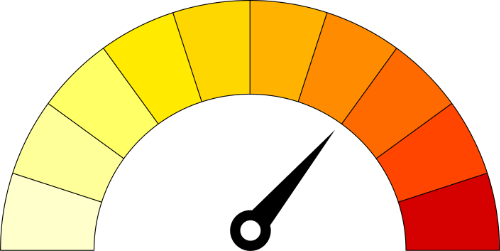
Your rating
Listening to Gustav Holst’s The Planets, is like riding a roller-coaster of contradictory emotions.
This probably sounds unduly poetic or perhaps even corny. But, really, from the threatening-sounding Mars, the Bringer of War, to the delicate melody of Jupiter, the Bringer of Jollity that almost brings me to tears (the episode Sleepytime from the animated TV show “Bluey” may have contributed to that), there is a high chance you’ll find a movement to your liking.
Despite being over 100 years old, The Planets remains one of the most celebrated and played works in the classical music repertoire, and in this article we’ll explore the meaning of it.
The Planets (op. 32) is a seven-movement orchestral suite written by Englishman Gustav Holst (1874-1934) between the years of 1914 and 1916.
Each movement was named after a planet from our solar system (Mars, Venus, Mercury, Jupiter, Saturn, Uranus and Neptune, in this order), and is supposed to reflect its astrological character, rather than astronomical significance.
Even though critical opinion was initially divided, even the harshest critics quickly changed their mind and praised The Planets as one of the most original and ambitious works of the time.
Interestingly, the fame that The Planets received during Holst’s lifetime was exactly what disenchanted Holst about the work. Somewhat paradoxically, Holst’s career was negatively affected by The Planets incredible success, as his other works were completely overshadowed and never received sufficient recognition.
As a result, Holst maintained a certain distance to the composition until his death.
For example, Pluto wasn’t incorporated in Holst’s composition because it was only discovered in 1930, almost 15 years after completion of the work.
Holst was still alive when scientists discovered Pluto, but he quickly brushed off enthusiasts’ pledges to produce another movement in honour of the newly-discovered planet. He simply had had enough of it.
As a whole, The Planets is a provocative piece. Like many innovative compositions ahead of their time, nothing like it had ever been attempted before. Even by today’s standards “The Planets” remains almost, well, unearthly.
The time signatures vary significantly within and across pieces. For example, “Mars” is mostly on 5/4, whereas other movements switch between time signatures (e.g., Jupiter goes from 2/4 to ¾). There are also complex cross-rythms in several of the movements like in “Mercury” and “Uranus”, with unusual time signatures like 9/4.
In some movements, Holst makes clever use of hemiolas, one of his favourite compositional techniques. For example, at some point in Uranus, part of the orchestra is playing in 4/4 meter, while the bass, oboe, clarinet and bassoon all play in 6/4 meter. Similarly, in Mercury, hemiolas are created by contrasting block chords in ¾ with 6/8 meter.
There is also a lot of harmonic dissonances throughout the suite, and, in most cases, they function as a way to either evoke feelings of trepidation or the perception of threat.
The Planets has been hugely influential in contemporary music as well. You may have heard about a certain composer called John Williams, who wrote music for a certain movie franchise called Star Wars?
Well, if you listen to Mars, the Bringer of War (the very first movement of The Planets), you will surely have no trouble associating it with the beat to the Stormtroopers March. Indeed, The Planets sounds as though it had been devised with cinema in mind, even though motion pictures with sound-on-film was yet to be invented.
And let’s not forget that a faithful execution of The Planets requires a gargantuan orchestra (although not as large as the likes of Mahler or Schoenberg): 16 woodwind players, 15 brass players, several percussion instruments, a massive organ, dozens of string players, and an only-women choir for the last movement.
I have to admit that, as a classical music aficionado, my evaluation of classical music pieces will tend to be somewhat biased. Nevertheless, the very fact that The Planets has remained popular for more than a century now, and has had an incredible impact on the music industry, is a testament to its quality.
It is only unfortunate that Holst completely lost motivation and desire to expand the composition after it had become such a huge success. But considering the negative effect this fame had on his later career, no-one could fault Holst for that.
In Mindlybiz, The Planets gets a star rating of 5.
There are no lyrics in Holst composition, therefore, bizarreness needs to be evaluated on the basis of the compositional techniques Holst employed.
The Planets was quite innovative at the time, and when it was initial presented to the public, it was received with a certain amount of apprehension. I believe this speaks for how strange the suite may have sounded to the ears of early twentieth-century society. Even nowadays, The Planets is a matter of study and extensive musical analysis.
The unusual musical progression and its associations with the occult, coupled with complex polyrythms, bitonality, unconventional time signatures, and generous use of dissonance makes this a relatively “weird” piece.
In Mindlybiz, The Planets gets a Bizarrometer of 3.5.
Gustav Holst had a penchant for many exotic interests that you would probably not associate with a classic composer. For example, as a student, he was an avid reader of Hindu literature and philosophy, and translated Rig Veda hymns without any experience as a linguist.
During holidays in Spain, Clifford Bax (the brother of composer Arnold Bax), impressed by Holst’s knowledge of Sanskrit texts, met with Holst and introduced him to Astrology. Holst was completely taken with it.
He diligently studied astrology to the point that he became a skilled interpreter of horoscopes.
The Planets emerged during this enticing period of his career. Indeed, Holst always maintained that the planets in his composition expressed each planet’s astrological character, rather than their astronomical or mythological significance.
The order that the planets appear in Holst’s work does not correspond to the ordering of the planets from the Sun. Instead, Holst arranged the planets in terms of proximity to Earth (Mars, Venus, Mercury, Jupiter, Saturn, Uranus, Neptune), with the exception of Mars, which should have been placed second after Venus.
The reason Holst decided to use Mars as the first movement isn’t clear, but likely relates to musical effectiveness. Mars builds up tension, and unleashes a climax, which is an ingenious way to keep the audience engaged from the get-go.
“Mars, the Bringer of War” is very much like a war march. Astrologers associate the planet Mars with violence, anger and destruction, but also of energy and action. And in this first movement, there is tension-building throughout literally the entire piece and an almost aggressive and explosive musical atmosphere.
In “Venus, the Bringer of Peace”, the contrast to the preceding movement couldn’t be greater. In Astrology, Venus is linked with beauty, peace, harmony and pleasure. This movement has the peculiarity of not incorporating any tension, so the entire movement is very hypnotic and peaceful.
“Mercury, the Winged Messenger” is the most swift and ephemerous movement of the seven. In Astrology, the planet Mercury represents communication and the way you express yourself. Indeed, in this movement, instruments play and pass the same melody around, as though a message were being relayed across the entire orchestra.
“Jupiter, the Bringer of Jollity” is the most cheerful movement of the suite. It starts with a majestic entrance, and retains this optimism throughout the piece, as if we were attending a feast of the god of the Gods (i.e., Jupiter). In Astrology, Jupiter is considered the planet of good-fortune, abundance and growth. The Waltz-like middle section leading to the beautiful melody of the “I Vow to Thee, My Country”, invokes images of peace and serenity.
“Saturn, the Bringer of Old Age” is the most ominous piece of the suite. It always lingers in this uncomfortable atmosphere where death and despair seem ubiquitous. The middle section gives the idea of approaching gigantic footsteps as if an epic battle were about to erupt. In Astrology, Saturn is the planet that enables you to overcome your fears and face the vicissitudes of life. In fact, as opposed to the other movements, Saturn appears to contain a plot-like structure to the piece: starting with a problem, exploration, confrontation, revival and resolution.
“Uranus, the Magician” starts with a fanfare of brass instruments, which develops into the downright wacky middle section. Astrologers considered Uranus to be the planet of technology, invention, originality and eccentricity. Holst’s employment of unusual time signatures and experimentation with unconventional orchestral instruments does indeed this planet’s title justice.
“Neptune, the Mystic” is perhaps the most musically obscure of the movements. In Astrology, Neptune is linked with psychic abilities, dreams and visions, all characteristics that are expressed in the music of Neptune through the employment of harmonic dissonance. Furthermore, this movement ends with a surprising faded-out only-female voices, adding extra mystery to the ultimate goal of the piece.
Note the deliberate omission of Earth from the list. This is because, in Astrology, Earth is at the center of the chart (the so-called geocentric chart). Thus, everything is relative to our position on Earth, which is why it isn’t usually considered.
But let’s first get acquainted with some of the concepts in Astrology before embarking on a more meticulous analysis of Holst’s work.

Before explaining the relationship between the planets and astrology, it is first important to get familiar with a few concepts in astronomy, namely the ecliptic and the zodiac constellations.
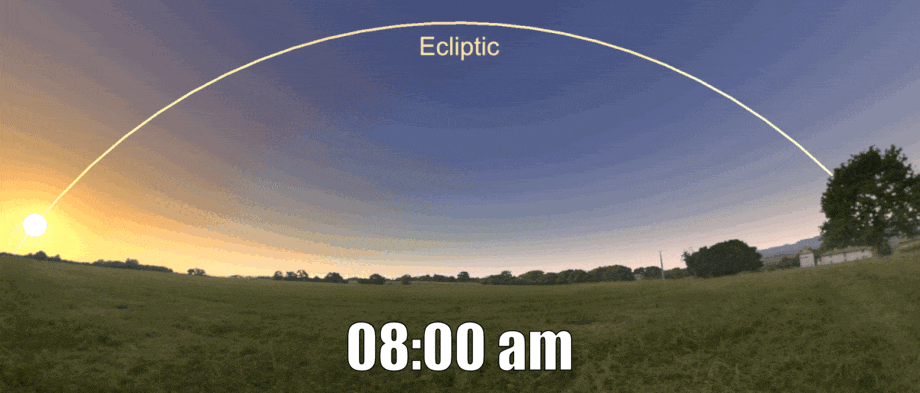
I hope it comes as no surprise to you that it is the Earth (and all other planets) that orbit around the Sun.
Now, from the perspective of someone standing on Earth, it will appear as though the Sun is moving across the sky, right? Imagine that you could trace the path of the Sun from the moment it rises in the East and sets in the West. You would be tracing something called the ecliptic (see figure above).
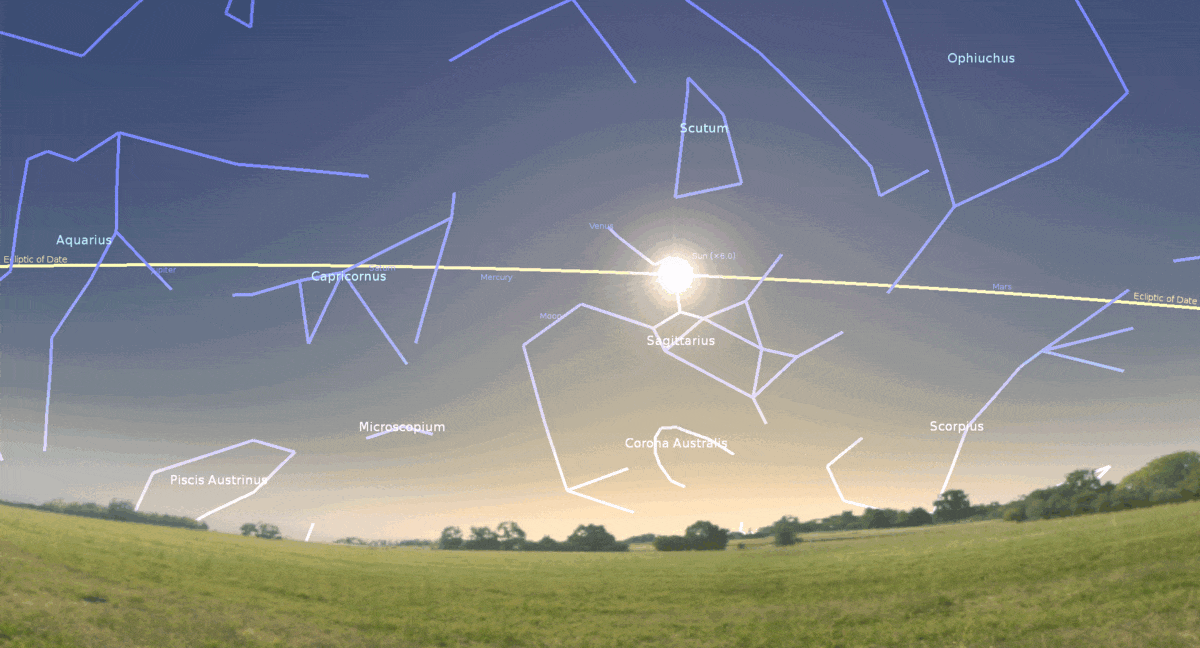
Because the sun is so bright, you don’t see any stars in the sky during daylight. However, if you were to remove the atmosphere, you would see the Sun in the foreground of a background of stars (see image above).
So, from the perspective of someone on Earth, the ecliptic is the imaginary line the Sun appears to take through the background stars.
The other planets in our solar system travel more or less on the ecliptic as well; some are a few degrees above it, some a few degrees under it, but more or less on the ecliptic plane (e.g., in the image above you can just about spot Jupiter close to Aquarius and Venus close to Sagittarius).
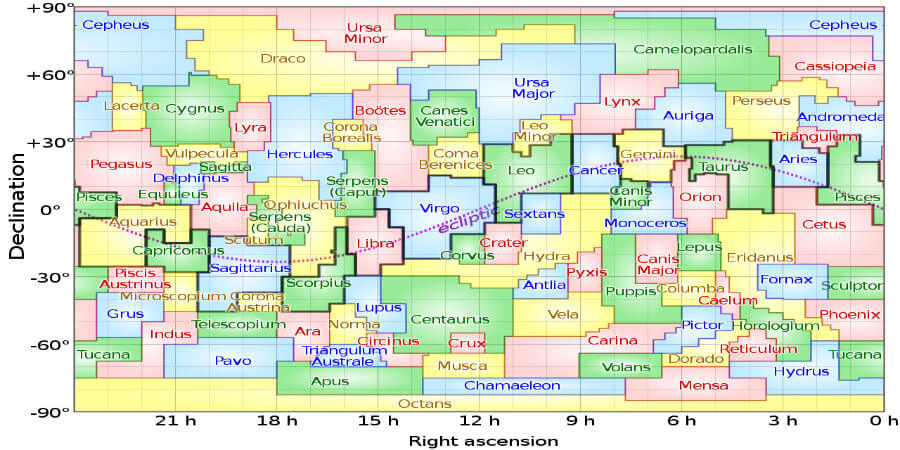
When you look up in the sky you can see many stars right? Ancient civilizations all over the world found it helpful to group some of these stars together and give them names – these became the constellations.
Nowadays, every farmer knows that we should sow in the spring and harvest in the fall. However, before the invention of calendars, people had no clue when they should start sowing or harvesting.
So, they relied on patterns of stars in the sky (the constellations). For example, when the constellation of Orion was beginning to become fully visible, people would know that winter was approaching, a cue to start harvesting. Similarly, whenever they spotted the Summer Triangle they would know spring had arrived, their cue to start planting.
Constellations also helped in navigation. Sailors would use the night stars and constellations to navigate their ships across entire oceans, helping them discover continents like America and Oceania.
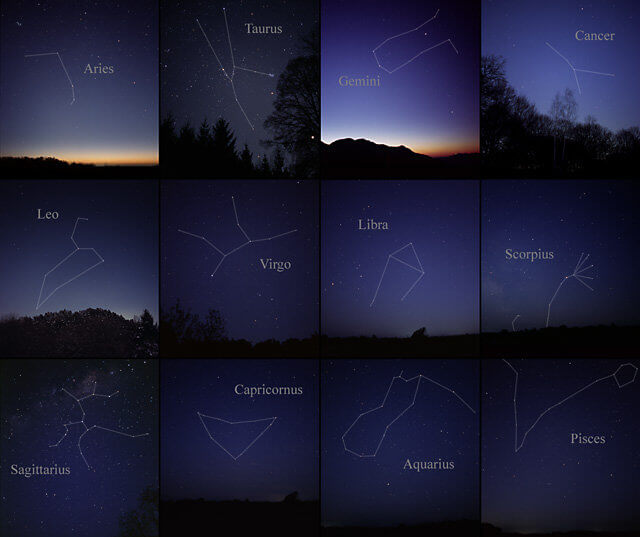
At present, there are about 88 constellations named by humans, but there are 13 that are particularly well-known: the constellations of the zodiac. They are Aries, Taurus, Gemini, Cancer, Leo, Virgo, Libra, Scorpio, Ophiucus, Sagittarius, Capricorn, Aquarius and Pisces. Each is associated with a specific object or animal, but most do not look anything like it.
In astronomy, there are indeed 13 constellations of the zodiac.
Apart from the 12 well-known constellations that are also the names of the astrological signs, there is another constellation lying between the constellation of Scorpius and Sagittarius called Ophiucus. It is visible between the 30th November and 18th December.
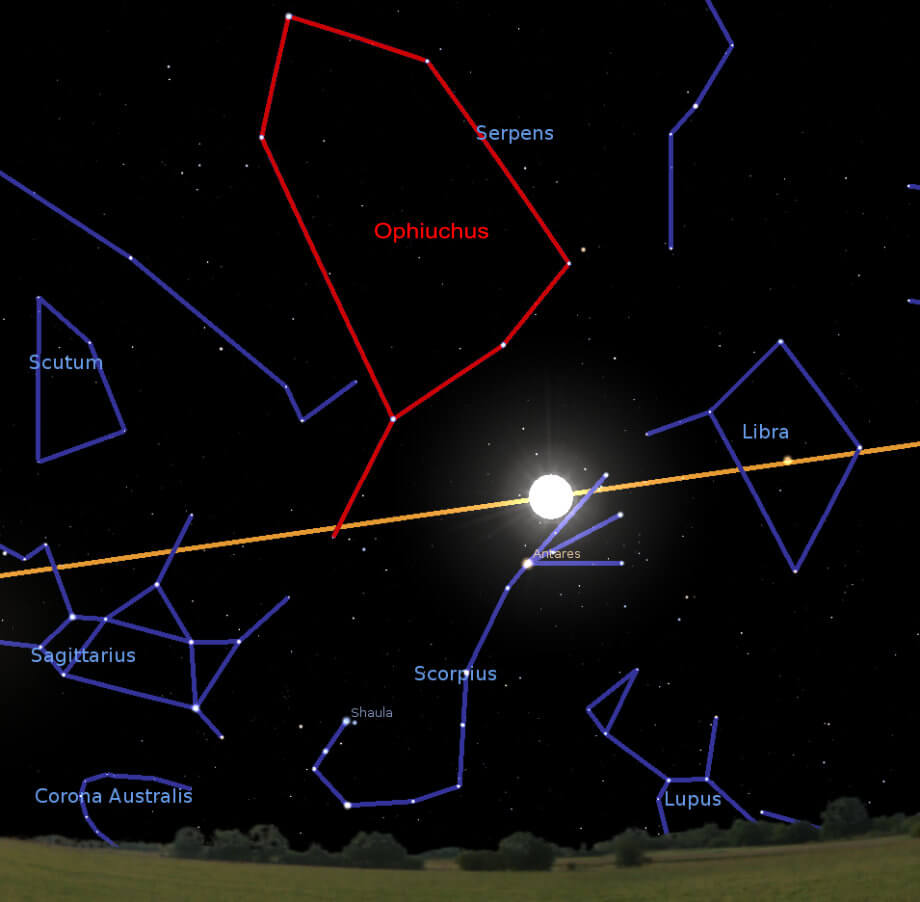
Ophiucus is a relatively large constellation (highlighted in red in the image above) and, importantly, it crosses the ecliptic (the yellow line in the image above). So why have astrologers ignored it?
One of the reasons could be due to the fact that if you include Ophiucus, the number of constellations would be 13, a number which has been traditionally associated with bad luck.
Another reason might be that astrologers divide the sky into angles of 30 degrees, which multiplied by 12, gives us 360 degrees, the extent of the ecliptic plane. Now, with 13 constellations that number would be 360/13 = 27,692307… which is not as much of a clean number as 30 degrees.
The problem is that the Sun is in Scorpius for only 6 days, whereas it is in Ophiucus for about 20 days. So astrologers decided to fuse Scorpius with Ophiucus so that the time is closer to the 30 days mark.
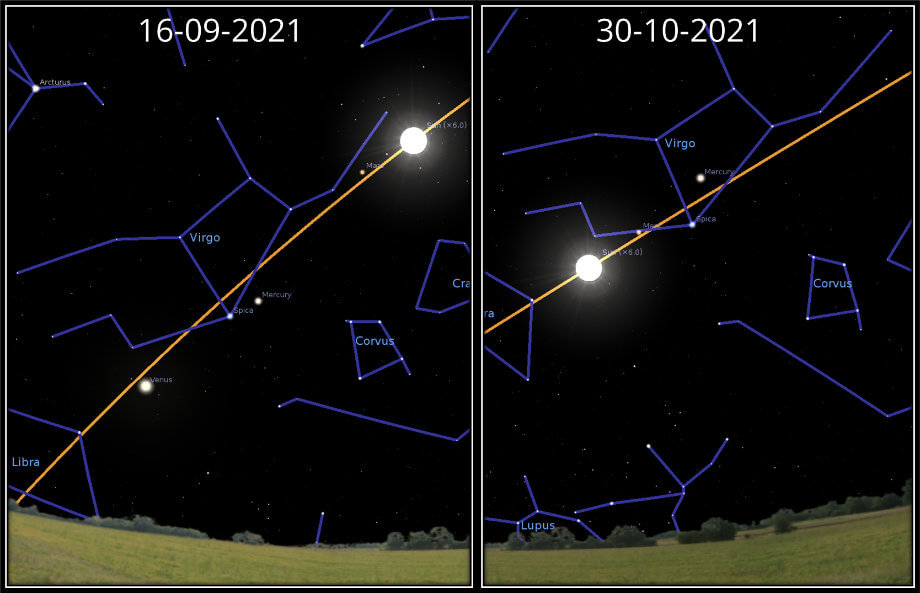
Now, because the sun rays are so bright, you cannot see any stars during the day. However, if you were to remove the atmosphere, you would see the Sun more or less “in front” of one of the 13 constellations of the zodiac.
The amount of time the sun spends on each constellation varies from approximately 5 days (Scorpio) to about 44 days (Virgo; see image above).
Now, there are only 12 zodiac signs in western astrology. This is because astrologers decided that Ophiucus should be merged with Scorpius, resulting in the 12 constellations that any astrology fan can recognise (check Say what?!? Ophiucus?!? Not in my horoscope list…)
12 is also a nice number because you can divide 360 degrees (the ecliptic plane) by 12 and you get 30 degrees of celestial longitude (30 degrees is more or less the distance the Earth revolves around the Sun in a month).
I’m afraid yes!
You see, the Earth is not a perfect sphere so it’s mass is not distributed equally. Because of this, Earth wobbles around itself like a spinning top. This is called precession.
At the time of the Babylonians (2nd Millennium BC, when astrology was invented), the position of the Sun in the zodiac constellations more or less matched their astrological equivalent. For example, people born in early October were in fact Libra because, at the time of the Babylonians, the Sun was indeed in Libra in early October.
But that was 2500 years ago!
As I mentioned above, the Earth wobbles on itself. With each change in “wobbling” the constellations slide significantly eastwards. On an average human life that sliding is only about one degree (which is insignificant). But over 2500 years it starts to add up.
In fact, since 2500 years ago, the Earth precession has changed about 30 degrees. That means that if you were now born on the 21st of February, your astrological sun sign will be Pisces. However, on that day, the Sun was actually travelling the constellation of Aquarius (Aquarius is 30 degrees eastward of Pisces).
In order for the constellations to be in the same position as that for the Babylonians, we will need to wait about 22,000 years (it takes 26,000 years for Earth to complete one full “wobble”).
Just as the Sun “travels” by the zodiac constellations in the sky, so do the other planets of our solar system (see figure above).
For example, if you were born in February 21st, your Sun astrological sign would be Pisces (even though the Sun would actually be in Aquarius; see left image above). If Jupiter happened to be in the constellation of Capricornus at the time of your birth, then you would have “Jupiter in Capricornus”.
If, instead, you were born in June 29th, your Sun astrological sign would be Cancer (even though the Sun would actually be in Gemini; see right image above). If, at the time of your birth, Mercury happened to be travelling by the constellation of Taurus, then it is said you have “Mercury in Taurus”.
Also note that two or more planets can occupy the same constellation. For example, if Mercury and Saturn were both in Virgo, then both Mercury and Saturn would be in Virgo.
Most astrologers consider the 5 first planets counting from the Sun (Mercury, Venus, Mars, Jupiter and Saturn) as the most important; they are considered the personal planets, because they are closer to Earth.
More specifically, the Sun, the Moon, Mercury, Venus and Mars reflect how people behave, whereas Jupiter and Saturn reflect our social tendencies.
Uranus, Neptune and Pluto are considered to be the transpersonal planets in Astrology.
Conveniently, each planet has at least one keyword which describes the essence of that planet, so you can get the gist of each planet’s character:
| Planet | Keyword |
|---|---|
| Mercury | Communication |
| Venus | Love |
| Mars | Activity |
| Jupiter | Expansion |
| Saturn | Restriction |
| Uranus | Revolution |
| Neptune | Imagination |
In the next sections I will expand on the ideas behind the astrological significance of these 7 planets (I’ll focus on only 7 of the planets: Mercury, Venus, Mars, Jupiter, Saturn, Uranus and Neptune, since these are the planets we encounter in Holst’s composition).
I will also give some examples of how astrologers might interpret the planets depending on which zodiac constellation they are positioned in.

In Roman mythology, Mercury is the god of communication, commerce and messages.
He is considered to be the messenger of the gods, and is often depicted wearing winged sandals and a winged hat, and carrying a caduceus.
It was Mercury who, according to mythology, was in charge of guiding the souls of the dead to the boatman Charon, who would then ferry the souls down to the underworld.
In astrology, Mercury is associated with learning, intelligence, and everything related to communication. It determines the way you think, how you use language and express yourself, as well as the speed with which you process information and understand facts.
Mercury in Aries
If you are Aires and ruled by Mercury, you will be very assertive and will not hold back your opinions. Your mind is always racing, so you might at times be slightly impatient and even find hard to concentrate.
Mercury in Gemini
Aided by your extraordinary curious and percepive mind, you are a very intelligent person. If you need to juggle several tasks, you don’t falter. Your agility to roam new environments and adapt to new circumstances is legendary.

Venus is the brightest “star” you can see in the sky. Perhaps for this reason, many ancient cultures associated this planet with the goddess of love. According to mythology, Venus was the unfaithful wife of Vulcan, who nearly caught her in the act with Mars.
Thus, astrologers have found it pertinent to associate the planet Venus with things like love, seduction, beauty and pleasure.
How you deal with, and express your affections and desires has to do very much with planet Venus. It is also Venus who is responsible for the quality of your interactions with other people, whether those interactions are friendly, social or purely sexual.
In general terms, Venus represents your entire romantic spectrum.
Venus in Virgo
If Venus is in Virgo, you approach your romantic quests with honesty and maturity. Once you fall in love, you are completely engaged, exploring every nook and crannies of the relationship. You don’t leave anything to chance. Being a fully devoted partner, it could sometimes mean that you are slightly controlling and critical.
Venus in Sagittarius
Love should be an adventure to you, so when you look for a partner, you tend to value qualities such as openness to new experiences, travelling around the world, and so on. You avoid being chained away into stagnant relationships, even if they feel secure. People with strong personalities and diverse interests captivate you, even if they raise other people’s eyebrows.

Mars has a slight red tint when you look up in the sky. For this reason, many ancient cultures associated this planet with destruction and death.
In Roman mythology, Mars is the god of war, so many astrologers have associated Mars with many negative aspects, such as violence, anger, dishonesty and bad temper.
However, there is also a positive side. Mars is geared into action. He is strong, determined, energetic and courageous. Inactivity is something alien to Mars; when he sets his mind he makes sure he will get it.
So, more generally, Mars represents your tenacity, energy, ambitions and desires as well as your ability to take on new ventures.
Mars in Aires
You are as brave as you are impulsive, which may sometimes put you in precarious situations. You are known for bouts of emotional explosions, which you may find difficult to control. But that energy and enthusiasm make you an excellent leader, and you don’t shy away when you are in the spotlight.
Mars in Libra
Despite being an easy-going and friendly individual, you might struggle to assert yourself. You don’t like conflicts, so you often avoid war and will always seek harmony. But that behaviour comes at a price. By trying to look at all sides of the problem in order to reach the most harmonious conclusion can result in indecisiveness. So you might have difficulties making decisions, even ones that only relate to you.

Being the largest planet in our solar system, Jupiter was named after the king of the gods: Jupiter Optimus Maximus.
So it isn’t surprising that astrologers found that attributes such as abundance, optimism, growth and cheerfulness, best characterised this planet. Jupiter is the bringer of luck, opportunity and success, although it can also express overindulgence.
Jupiter in Taurus
You are someone who relishes pleasure and material things, so sometimes you may fall prey to some self-indulgence. Nevertheless, you are not an unreasonable person, and your affinity for practical things often means you make wise choices (such as saving money).
Jupiter in Scorpius
You are a reserved but perspicacious individual, with a genuine interest in getting to know more about the subject of your inspection. You are also ambitious and proud in your endeavours, characteristics which could be helpful in pursuing your passions.

In mythology, Saturn is equivalent to the greek god Cronus, the god of time.
Astrologers associate Saturn with discipline, organisation and accomplishment.
Essentially, Saturn drives you to find solutions to existing problems, to get organised and to push your limits. Whenever you feel down, lazy or face obstacles of any kind, Saturn will force you to fight back and never conform.
Saturn in Cancer
Possibly as a result of a difficult childhood, you may experience feelings of insecurity and emotional dependance later in life. You will have a tendency to seek ways to fill that lacuna. This could bring a bunch of problems. For example, you may become needy in your romantic relationships, or you may act super-confident or indifferent in order to mask your vulnerabilities.
Saturn in Aquarius
If Saturn rules Aquarius, then you will be someone with the ability of persuasion (the good kind). You are just, kind, creative and cognitively flexible. These traits enable you to understand your place in society as a constituent part working towards a common goal. In addition, you feel that you only strive if you live according to your own values, which are mostly noble and not so much related to material objects.

In astrology, Uranus is considered the planet of technology, revolution and modern age.
In personal terms, it reflects that side of you that is inventive and creative, and attempts to break away from convention. In this sense, it can help generate those “Aha!” moments when you least expect.
Although Uranus’ influence can lead to life-altering events (e.g., a promotion, a significant scientific discover), it can also induce disruptive states of mind and less appealing consequences (e.g., unexpected break-up, housing predicament, financial problems).
Uranus in Leo
While you are a creative and talented individual who revel in exciting and challenging projects, you can at times be arrogant and vain. You also don’t mind unconventional romantic relationships, in fact, you actively seek them.
Uranus in Capricorn
If there is something you cannot stand is to live a life according a particular set of rules. This will have an impact on your career. For example, if your workplace is conducive for expressing your individuality, then you will do great. However, if your individuality is unwelcome, then you won’t conform.

Neptune is the god of water and sea in Roman mythology, but in astrology, the planet symbolises the occult, as well as intuition, imagination and dreams. It is in Neptune where your artistic ability comes off, be it expressed in dance, music or any other art.
The more negative aspects of the planet are the increase risk of addiction, hypochondria, social withdrawal and aimless drifting.
Neptune in Scorpio
You are someone who is fascinated by the workings of the mind. You will tend to look into the occult arts, dream interpretation. However, you might also be more prone to self-destructive behaviour.
Neptune in Pisces
Astrologically, Neptune is currently in Pisces (as of 2022), so individuals born between 2012 and 2026, are often empathetic and generous, highly artistic with a penchant for fantasy, cinema and music. On a more negative side, these individuals may exhibit addictive tendencies and self-destructive behaviour.
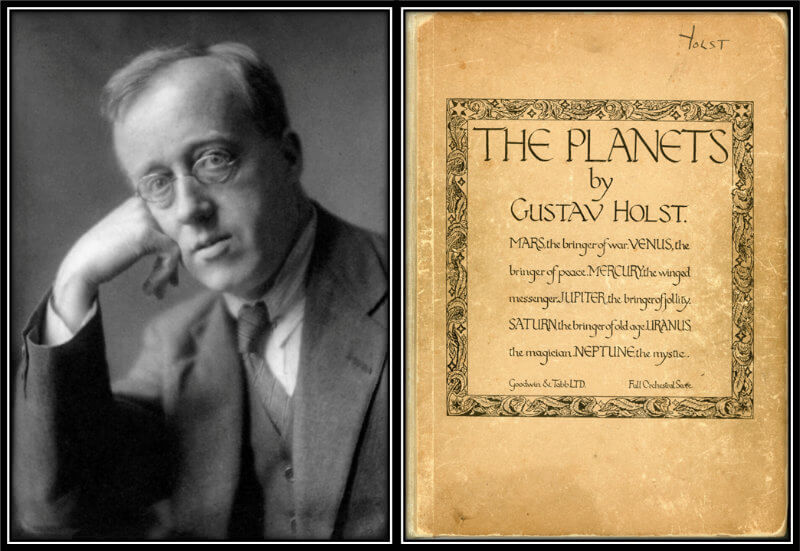
The Planets suite is composed of seven movements that refer to seven of the planets of the solar system.
Holst became interested in the planets through astrology. After 1913, he became quite adept at casting his friends’ horoscopes. It was probably during this period that Holst began associating particular astrological qualities to each the planets.
Remember the order of the planets? It goes: Mercury, Venus, Earth, Mars, Jupiter, Saturn, Uranus, Neptune.
Holst completely ignored this order in The Planets. In this work Mars comes first, followed by Venus, Mercury, Jupiter, Saturn, Uranus and Neptune.
Earth was excluded, since it’s not considered a planet in Astrology. Pluto was only discovered after Holst published the work, and he refused to write another movement for it.
So let’s start the analysis of The Planets movement by movement.
In Astrology, Mars is linked with several negative aspects such as violence, anger and impulsivity. It is also associated with action, energy and driving force.
Holst was spot-on in conveying these attributes in the first movement of his suite, without the recourse to lyrics.
This movement is easily recognisable by the intimidatory snare drums and brass instruments that shape the initial motif. You can feel a dark and ominous tension building up, as if warning us of an impending war cataclysm that is about to erupt:
Even the string instruments are contributing to this war march by playing “con legno battuto”, meaning they are striking the strings of the instrument with the stick of the bow.
The orchestra is instructed to play loud, and it’s really quite powerful. I’ve listened to this movement many, many times, and it always feels uncomfortable (which is the result of Holst’s employment of harmonic dissonance and irregular metre).
If that wasn’t enough, Holst keeps the cycle going, building up tension and releasing it at least three times in this single movement.
I find it impressive that Holst chose this movement to be the very first movement, because it finalises with such incredible force that it would be apt for an epic finale of the suite.
Specifically, the last seconds of the movement end with a few powerful chords. Try to predict when those chords are coming – I bet you can’t! This gives us a feeling of conflict, of desperation, confusion. So we long for a resolution, which is delivered at the very end:
In a striking coincidence, Mars the bringer of War was composed only two months before the outbreak of World War I.
In Astrology, Venus is associated with everything beautiful and romantic, e.g., love, seduction, beauty pleasure, and all sort of positive emotions that allows you to express yourself affectionately towards others.
Placing Venus after Mars is nothing short of peculiar. As mentioned above, Mars, the god of War, is infamous for his impulsive and combative behaviour, always on the lookout for an opportunity to act out his aggressive nature.
In contrast, Venus, the goddess of love advocates peace and harmony.
According to mythology, Venus is Mars’ mistress, and in many artistic works she is seen attempting to appease Mars while he runs amok, inciting violence wherever he goes (check out our article about Guernica where we analyse “Rubens’ painting “The Consequences of War”).
So, perhaps Holst wished to create this contrast in his first two movements of The Planets: a fiery entrance by Mars, followed by the gentle Venus and her attempt to bring calm and peace.
The movement Venus, the Bringer of Peace, begins with a soft melody, brought about by the brass and woodwinds instruments, as well as a harp. It has a sort of hypnotic or dreamlike vibe to it.
As opposed to Mars, the Bringer of War, you mostly feel relaxed and at ease when listening to this movement. Holst hardly induced any tension here, so you are left with a steady trance-like atmosphere, as if you are yourself in an undulating motion. This effect is partly achieved as a result of different instruments playing overlapping patterns (a sort of passing of voices), giving a feeling of oscillation:
The peaceful and soft melodies of Venus are reminiscent of music written for romantic movies (although I discourage you to picture images like that when listening to the Planets, as to not distract yourself from the nuances of the composition).
The movement ends with a very gentle texture, which I think was an ingenious way to finalise Venus, as it evokes tranquility and brings about closure to the apocalyptic movement of Mars:
The planet Mercury has the fastest orbit around the Sun – a mere 88 days.
It is, therefore, interesting that Mercury, the Winged Messenger is also not only the shortest movement (around 4 minutes) but also quite quick-paced.
In mythology, Mercury is the god associated with messages and communication. He wore winged sandals which endowed him with the ability to move at great speeds. So the title of this movement, Mercury, the Winged Messenger, is quite fitting.
Astrologers retained this idea of communication but expanded its meaning by incorporating fluid intelligence, how quick and effective people process information and solve problems.
And if there is a movement in The Planets that seems to convey the idea of communication is certainly Mercury. The entire movement appears to flow as a series of questions and answers.
There is a particular melodic phrase that is played 12 times in row, which you would think must get boring to listen to. Cleverly, Holst had the idea of having different instruments play the theme sequentially, as if a message were being passed around the orchestra:
What is more, cross-rythm is very obvious in Mercury. Holst has some instruments play in 6/8, ¾ and 2/4, creating a vibrant rythmic structure, so you never really feel that there is any repetition whatsoever:
In the excerpt above you will also notice that Holst has the orchestra play in different key signatures: some instruments play with flats in their key signature, some with sharps, some with neither.
It is a mishmash of tonality even for similar musical phrases, which, again, could represent this idea of communication among the instruments (playing similar musical patterns in different tonalities similar to how different languages can express the same meaning).
Ahhhh, Jupiter.
This is probably the most famous movement of the composition, and the fame is well deserved.
Relative to the other planets in the solar system, Jupiter is the fastest spinning planet: it performs a full rotation on its axis once every 10 hours or so (compare this to Earth which completes a rotation in 24 h).
This fact that didn’t seem to go unnoticed by Holst, who asked the violins to play a three-note pattern very rapidly at the beginning of the movement. It is as though the strings are prefacing the arrival of gods in a festive event. And what better way to announce this arrival than with the six French horns, violins and cellos:
Later the motif is taken over by the brass, low woodwind and timpani. The way Holst employs the timpani is particularly ingenious. There is no way one timpanist could actually play all the notes alone, so Holst has two timpanists share the music:
Jupiter is quite quirky, light-hearted and with many flavours. The movement is split into different sections with very sharp boundaries between them, so one can immediately tell once a new section commences.
Cleverly, Holst mixes up the cheerful rhythmic patterns and melodic themes from different sections, as if a conjoint celebration was taking place. The name Jollity could not be better suited.
After the initial frolic, we suddenly enter a new section with a completely different time signature (3/4). The Waltz-like playing is a testament to Holst’s passion for folk music. The same recurring pattern is played each time with some slight variations in instrumentation, tempo, and ornamentation (which seems to be something of a theme in pretty much every movement of The Planets):
After a harmonic feast, we enter the section with the most glorious theme of the entire suite. It starts off with some very strange chord progressions and rhythmic ambiguity, confusing the listener about what is about to come:
But suddenly, this soft, gentle, nostalgic melody emerges, that transports us to the English countryside (Thaxted, perhaps?). If you are British this melody will hold a special significance to you, as it is the base melody of the British patriotic hymn “I Vow to Thee, My Country”:
I listen to a lot of classical music, and there are few melodies that have the ability to bring me to tears so regularly. By the way, I’m not British, and only later did I hear the text in connection to the hymn, so my fondness for this melody has nothing to do with patriotism.
I can tell you, however, that it has been shaped by the episode of Bluey. One of my daughters cried during the scene with Holst Jupiter in the background, and now I’m unable to listen to the movement without shedding a tear or two.
But can’t you also feel a certain optimism in this melody? In astrology, Jupiter is characterised by optimism and cheerfulness, as well as the bringer of luck and opportunity. These are all qualities that we can immediately associate with this movement.
What’s interesting is how this melodic line develops; it starts tentatively with horns and strings, with woodwind and trumpet joining shortly after. From here on, more and more instruments join in (including the timpani playing the bass line) until almost the entire orchestra is contributing to this rich and beautiful musical moment:
In the last section, the themes from all the previous sections are played interspersed, tempo increases, tension builds, ostinatos are all around, with the final chords finally announcing the end of the feast:
This was Holst’s personal favourite. It is also the longest movement of the seven: around 9 minutes and 40 seconds.
Saturn couldn’t be further from the cheerfulness of the previous movement. It starts slow, very slow, with very unusual dissonant harmonies, giving it a funeral march vibe. Flutes and harps alternate between two chords, not unlike a ticking clock:
Thus, the first associations that come to mind is that of the passing of time. In fact, with the addition of the double basses, violins and bass oboe playing a slow and ominous theme, the first associations we have is that with death and despair. The initial moments of this piece gives us a sense of disquiet, as if confronted with our own mortality.
The music then slowly starts to build with the addition of the trombones, trumpets, tuba and string instruments to become slightly more encouraging and satisfying, as though we are in a period of personal exploration:
However, at the end of the path we are confronted with our ghosts. And what imposing ghosts! The brass instruments play strong chords with the timpani in between getting louder and louder. The regular pesante playing suggesting heavy paces (likely of monsters or giants), coupled with the occasional errie sounding of the bells, sound as if death itself was approaching:
After the terror of the previous musical theme, we are left with a beautiful texture of harps and double bass. I interpret it as a sort of rebirth; we are reborn from the ashes of our incinerated self:
Gradually, the music turns into a completely different mood. When the violins enter, it is not scary or threatening anymore but rather serene and pleasant. It is almost as though we came to terms to the inevitability of our own mortality. Pay close attention how the bells sound; somehow they don’t sound eerie any longer, but rather festive, as if announcing a rite of passage:
So, I see Saturn as the prototypical plot structure: Problem → Exploration → Confrontation → Rebirth → Resolution
In Astrology, Saturn can be linked with fear, but also with perseverance, duty and accomplishment. It is through the influence of Saturn that we find creative solutions to problems currently affecting our lives; it assists in getting ourselves organised, prioritising sensibly, facing our limitations and confront reality.
So Holst likely took this idea of Saturn being the planet responsible for pushing your limits and fight back your limitations to develop a “plot” for Saturn, the Bringer of Old Age (Old Age here representing the entire stage of a human life).
Uranus is the most unconventional planet in our solar system. Whereas most planets have their spin axes at more or less right angles to their corresponding orbits around the Sun, Uranus is spinning on its side (i.e., its north pole is pointing towards the Sun).
The astronomical oddity of Uranus has been captured by astrologers. In Astrology, Uranus is the planet of technology, inventions and revolution. So it represents the side of you that tries to break away from conventions.
This is interesting because that is exactly what Holst does in Uranus: he breaks conventions. First, he combined some very unconventional brass instruments at the time, such as the tuba tenor and brass oboe. Second, he used a mix of time signatures like 4/4, 6/4 and 9/4, that make the rhythmic feel of the music ambiguous. Third, the movement is full of surprises, with a frenzy dance that is almost delirious.
Also, Uranus has the same peculiarity of most of the previous movements, with recurring patterns played between sections (such as the four-note brass motif), as well as jarring changes in mood.
Uranus begins with a fanfare of brass instruments and timpani, with a rare xylophone making a categorical appearance. It all sounds very chaotic, experimental, with most of the instruments playing short alternating phrases:
The music gradually builds up into the most famous section of this song: the wacky parade. The brass, woodwind, strings and percussion seem to be trying to get the upper hand, while we can just spot the xylophone playing rapid notes in between as if trying to get itself heard in this eccentric merrymaking. It is almost surreal:
And, then, abruptly, the crazy fanfare is replaced by a solemn passage, which doesn’t last long though. The four-note brass motiv returns, and, then, we hear the organ and tuba playing a very loud and intimidating note:
Towards the very end, the movement is left suspended a sort of drifting away into nothingness, a premonition of what is about to come next:
Within our solar system, Neptune is the furthest planet from the Sun. It had been discovered in 1846 (so 68 years before Holst began composing The Planets), but very little was known about it.
Perhaps for this reason, Neptune was given the name “The mystic”. Holst probably wanted to convey the idea of the mysterious planet drifting alone in space, never revealing its secrets.
There are numerous musical elements that allude to the mystic nature of the planet.
First, the movement starts with an inquisitive melodic phrase. The bells add to this mysteriousness, as if a communication with the supernatural was materialising.
The juxtaposition of the alto flute and the regular flute (e.g., the very first pattern you hear in the initial seconds of the movement) is so ingenious that it almost sounds like you are entering the twilight zone:
Second, the dissonance and ever-changing time signatures is recurring in this movement.
Third, the combined use of harps, strings and a celeste (a keyboard instrument which is used at the beginning of “Hedwig’s Theme” from the Harry Potter movies) really bring about the eeriness of this piece:
Finally, half-way through the movement you can hear the female voices of the choir gently emerging, only to fade out at the finale, giving us a feeling of continuity happening beyond the music.
Weirdly, Holst placed the female choir hidden from the audience, so when you listen this piece live, the voices sound as though they appear out of nowhere:
In astrological terms, Neptune is the planet of the occult, intuition, imagination, dreams, spirituality and psychic abilities. It has also been described as the planet of the illusion and deceit.
More pertinent, Neptune’s influence can also lead to a tendency to drift off course, which could bring about either a disruptive change or an inspiration for positive change.
And what better way to suggest drifting than the faded out voices in the finale. The question is though: did Holst intend it to represent aimless drifting or constructive drifting?
The Planets is a truly grandiose masterpiece. Holst was a terrific composer, and it’s only ironic that his most successful composition turned out to be the reason for the later downturn in his musical career.
The very first movement is Mars, the Bringer of War, full of power and energy, just as, in astrology, Mars is the planet of aggression and action.
Then comes Venus, the Bringer of Peace, a combination of beautiful, gentle and sweet melodies, as if to calm the terror brought by Mars. Indeed, in astrology, Venus is responsible for all romantic aspects of your life and is linked with positive attributes such as beauty, pleasure and love.
Mercury, the Winged Messenger, is next. In Astrology, Mercury is linked to every aspect of communication (social, emotional). This is most faithfully represented by the rapid playing of musical phrases and their circulation across a range of orchestral instruments.
The sweet melodies of Jupiter, the Bringer of Jollity, follows. Full of joy and optimism, it is a worthy hymn for a feast of gods. Indeed, in astrology, it is Jupiter that brings good fortune and good cheer.
After Jupiter comes Saturn, the Bringer of Old Age, a gloomy movement with some imposing and daunting musical passages that seem to presage a calamity. This movement has a clear-cut “plot”, dealing with confrontation and its subsquent resolution. Indeed, in astrology, it is Saturn that forces people to confront reality and find ways to overcome obstacles.
The next movement is Uranus, the Magician. In Astrology, Uranus is the planet of revolution, inventions and eccentricity. These are all qualities found in this movement, which brims with exuberance and avant-garde musicality.
And finally, Neptune, the Mystic. Its deeply dissonant sonority as well as downright bizarre musical patterns seem to express everything cabalistic and mysterious in the universe. Astrologers link this planet to everything connected to the psychic realm as well as to intuition and dreaming.
You might have also wondered how can a classical music piece ever get a bizarrometer score of 3.5? Really, classical music weird?!?
But even if you set aside the very oddities you find throughout the piece (irregular meter, dissonant chords, etc.), consider the progression of the movements in the suite.
While listening to the Planets, you experience a roller coaster of emotions with aggressive Mars, gentle Venus, brisk Mercury, sanguine Jupiter, funereal Saturn and revolutionary Uranus. And just when you expect Neptune to bring this exuberant display of emotions to a satysting grand finale, akin to most great symphonies, what does Holst decide to do? Exactly the opposite of what you expect! He terminates the suite with faded out voices! Really?!? Faded out voices?!? For a finale?!?
Surely, you agree it’s hard to get weirder classical music than that!
The Planets is truly a remarkable orchestral work. Even if you aren’t an avid classical music fan, you should really try to take an hour of your time and immerse yourself in this suite.
Despite its huge popularity, somehow, The Planets endures almost as an incognito piece.
You see, most people wouldn’t hesitate attributing “Für Elise” to Beethoven, “Turkish March” to Mozart, “Herrn der Ringe” to Wagner. But, outside classical music circles, the association between the composer Holst and the composition The Planets is nowhere nearly as entrenched.
Holst popularity after publishing The Planets vanished as swiftly as it had appeared. Despite several productive years, his subsequent musical output kept being inevitably compared with the Planets, and the public was never as receptive to Holst’s other works as they had been with The Planets.
I guess I now understand and relate to Holst’s dismay at the success The Planets had achieved… Don’t you?
See you in the next article!
Books
Orion, Rae. Astrology For Dummies.
Youtube
About Holst’s music:
Philharmonia Orchestra (check the Listening Guide; Holst’s The Planets videos)
Thank you for writing such an in depth analysis of the planets and including some basic info about astrology which I knew nothing about. I really enjoyed reading it and found it very informative. Read it whilst listening to the music.
Hi Jessica,
Thank you for your comment! I’m really happy you found the article an enjoyable read!